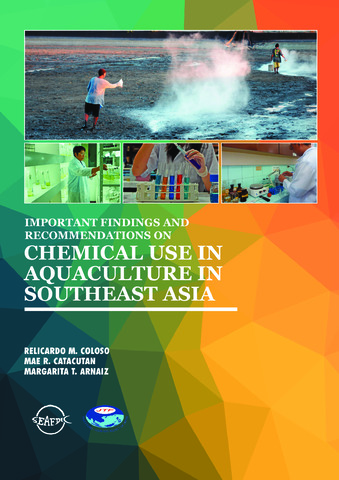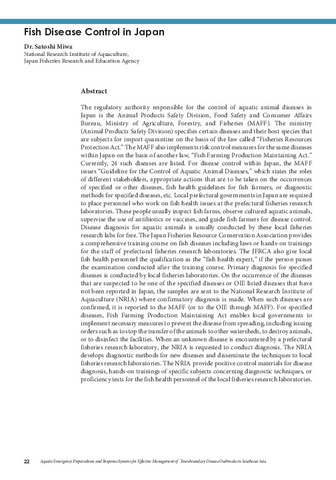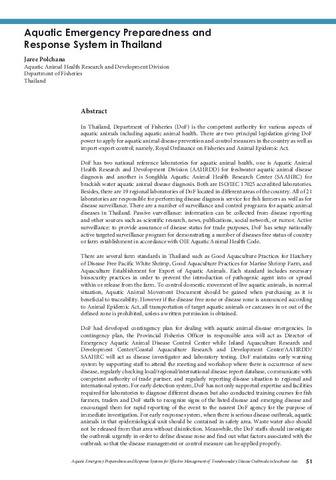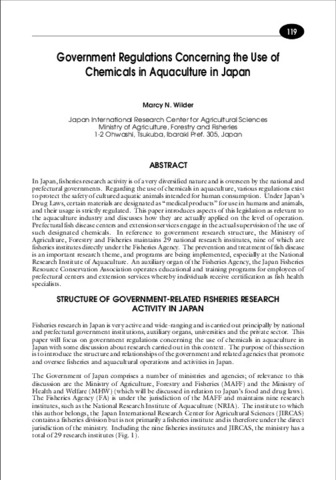Important findings and recommendations on chemical use in aquaculture in Southeast Asia
Share
ບົດຄັດຫຍໍ້
Under the program of Fisheries Consultative Group of the ASEAN (Association of South-East Asian Nations) - SEAFDEC (Southeast Asian Fisheries Development Center) Strategic Partnership Mechanism, a research project entitled “Food Safety of Aquaculture Products in Southeast Asia” was implemented by SEAFDEC/AQD (Aquaculture Department of SEAFDEC) from 2010 to 2014 with the financial support of the Government of Japan Trust Fund V (GOJ-TF5). The objectives of the project were to 1) contribute to the establishment of guidelines on the production of safe aquaculture products; 2) determine the presence and levels of commonly used chemicals in aquaculture in aquaculture products; 3) compile and disseminate SEAFDEC guidelines on the use of antibiotics and chemicals in aquaculture; and 4) implement training course/workshop to promote food safety awareness in the ASEAN region. Along with the said objectives, research activities, particularly focusing both on withdrawal periods of antibiotics often used in aquaculture and on surveillance of chemical contaminants in aquaculture products and feeds, were implemented (in 2010-2014). In addition, knowledge and technologies on food safety of aquaculture products were disseminated to local and national government staff, practitioners, stakeholders, etc. through an international seminar (in January 2011) and an international training course (in November 2013). Furthermore, AQD organized The International Workshop on Food Safety of Aquaculture Products in the Southeast Asia – Challenges in Sustaining the Food Safety of Aquaculture Products in May 2013 to promote and influence the regional initiatives in securing wholesome and safe aquaculture commodities in the ASEAN region. The publication of this volume consolidates the activities of the project which AQD has pursued during the period of the GOJ-TF5. Although the title of this volume does not include the word “guideline,” this volume surely includes and refers to the ASEAN guidelines recently published with the title of Guidelines for the Use of Chemicals in Aquaculture and Measures to Eliminate the Use of Harmful Chemicals courtesy of the ASEAN secretariat based on the understanding of the collaboration between ASEAN-SEAFDEC, as well as the basic and new findings of AQD scientists accomplished through the research activities, which were not covered by the ASEAN guidelines. Although the food safety of aquaculture products would be strictly required in the ASEAN region in the future, this volume will make a great contribution to the requirement.
Suggested Citation
Coloso, R. M., Catacutan, M. R., & Arnaiz, M. T. (2015). Important findings and recommendations on chemical use in aquaculture in Southeast Asia. Aquaculture Department, Southeast Asian Fisheries Development Center.
ວິຊາ
Related items
Showing items related by title, author, creator and subject.
-
Fish disease control in Japan
Miwa, Satoshi (Aquaculture Department, Southeast Asian Fisheries Development Center, 2019)The regulatory authority responsible for the control of aquatic animal diseases in Japan is the Animal Products Safety Division, Food Safety and Consumer Affairs Bureau, Ministry of Agriculture, Forestry, and Fisheries ... -
Aquatic emergency preparedness and response system in Thailand
Polchana, Jaree (Aquaculture Department, Southeast Asian Fisheries Development Center, 2019)In Thailand, Department of Fisheries (DoF) is the competent authority for various aspects of aquatic animals including aquatic animal health. There are two principal legislation giving DoF power to apply for aquatic animal ... -
Government regulations concerning the use of chemicals in aquaculture in Japan
Wilder, Marcy N. (Aquaculture Department, Southeast Asian Fisheries Development Center, 2000)In Japan, fisheries research activity is of a very diversified nature and is overseen by the national and prefectural governments. Regarding the use of chemicals in aquaculture, various regulations exist to protect the ...





